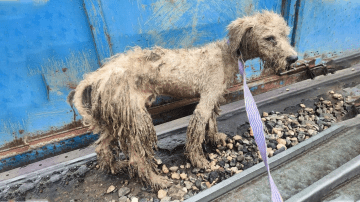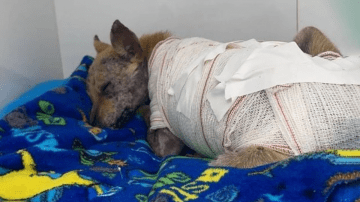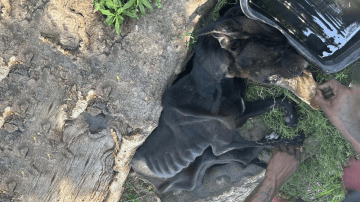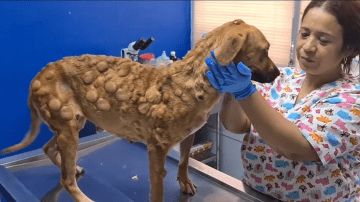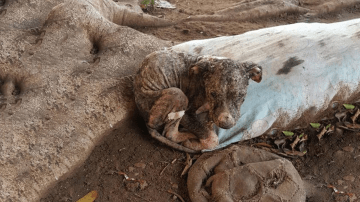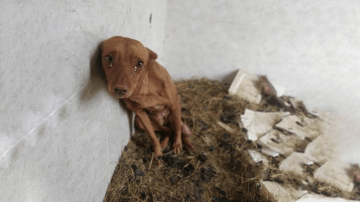The call came on a quiet afternoon: a small puppy had been abandoned deep inside a dense forest. I remember the weight in my chest as we grabbed what we could and set out immediately. A puppy left alone in such a place had little chance of survival. The shadows of the trees seemed to stretch endlessly as we searched, our hearts pounding with urgency. Hours slipped away, and the forest grew darker, quieter, as if holding its breath. Just as hope began to fade, we saw her.
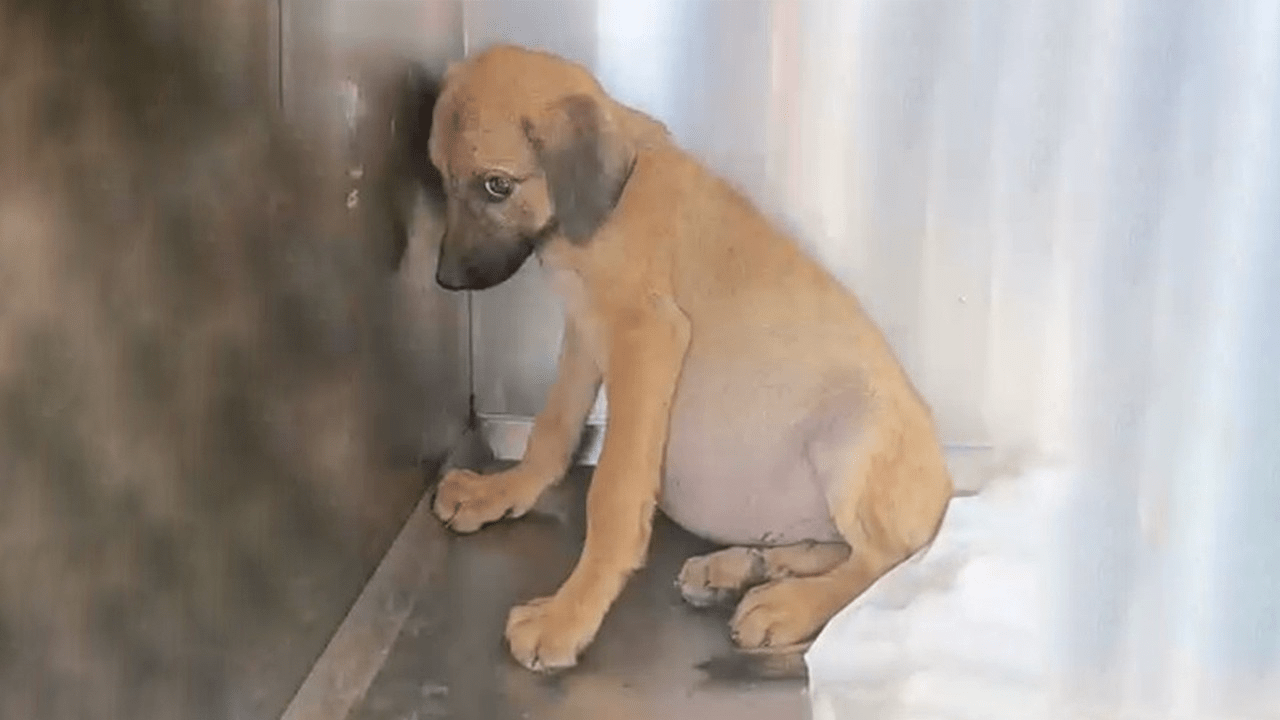
She was tiny, frail, and trembling, her body barely holding itself together. Her belly was grotesquely swollen, each shallow breath a battle. Her tail bore an open wound, raw and oozing, crawling with ants and parasites. The sight was almost unbearable—this fragile life, so close to giving up, surrounded by cruelty and neglect. I scooped her up gently, whispering promises she could not yet understand. She would not be alone anymore.
At the veterinary clinic, the truth of her suffering was revealed. Tests confirmed heart failure and a dangerous buildup of fluid in her abdomen. The vets worked urgently, draining nearly a full liter of fluid from her tiny body. She lay still through the procedure, too weak to resist, her fearful eyes searching the room as though she expected more pain. The doctors explained that her condition would require lifelong medication and careful management. Her body could be treated, but the deeper wounds—the invisible ones etched into her spirit—would take far longer to heal.
And yet, even in those first difficult days, she showed something remarkable. Though frightened, she did not fight us. She endured the needles, the tubes, the handling, with quiet cooperation. But her eyes… her eyes told the story of a soul scarred by betrayal. They were wide, sad, and cautious, as if she could not bring herself to believe that kindness was real.
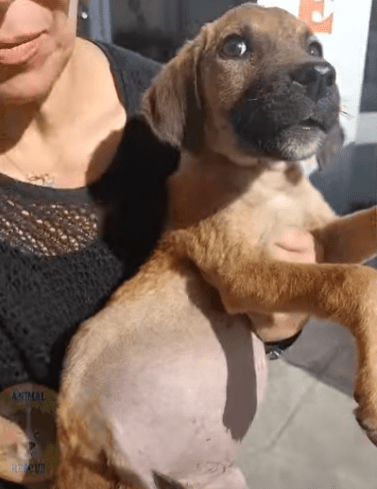
We began visiting her every day, determined to earn her trust. On the eleventh day, her physical wounds showed improvement—her tail was healing well, her belly less distended. But her body’s recovery did not reach her heart. She remained stiff when touched, distant, recoiling ever so slightly at affection. She ate the food we brought but avoided our gaze, never daring to meet our eyes for more than a second. It was as if she had built walls around herself, walls we could not yet break through.
By the twentieth day, her health had improved even more. The swelling in her abdomen had decreased, and she walked with greater steadiness. Yet her spirit was still heavy. She moved cautiously, her head lowered, avoiding contact whenever possible. To see her body heal while her soul remained so burdened was both hopeful and heartbreaking. She was alive—but not yet truly living.
On the thirtieth day, she was discharged from the vet. We carried her into our home, into a space filled with warmth and safety, hoping she could feel the difference. For the first time, she had a soft bed of her own, fresh water, regular meals, and the company of other dogs who had once known fear and abandonment themselves. Still, everything was strange to her. She stayed cautious, ate sparingly, and avoided interaction. When the other dogs wagged their tails and nudged her, she turned away. She did not yet know what it meant to belong.
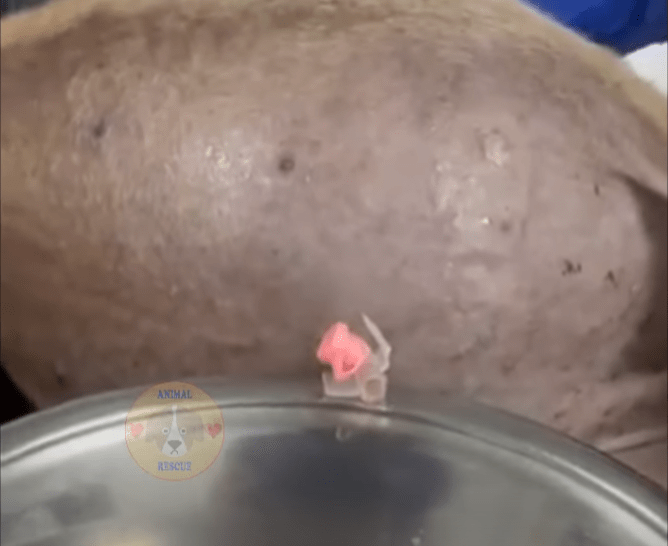
But healing is a slow process, and love requires patience. Day after day, we cared for her. We offered gentle touches, quiet words, and endless understanding. We took her on small outings, showing her the world could be safe, that new experiences did not always lead to pain. Gradually, almost imperceptibly, she began to change. She sniffed the air on walks, lingered a little longer at meal times, and allowed us to rest a hand on her back without pulling away.
We gave her a small house of her own, a place that was entirely hers. To our delight, she cherished it, keeping it clean and orderly as though it were her sanctuary. It became her safe haven, the place where fear loosened its grip and trust began to take root.
Over the weeks, her eyes transformed. The sadness that once clouded them gave way to brightness. The fear softened into curiosity. One morning, she wagged her tail when she saw us, and tears stung my eyes. It was the smallest gesture, but it meant everything. It was the moment she chose to let us in.
From then on, the changes came more quickly. She began to play with the other dogs, tentatively at first, then with growing joy. She chased after them, barked alongside them, and finally curled up with them to sleep. Her laughter—the sound of paws tapping on the ground, of happy yips—replaced the silence that once surrounded her. She had crossed the bridge from survival to living.
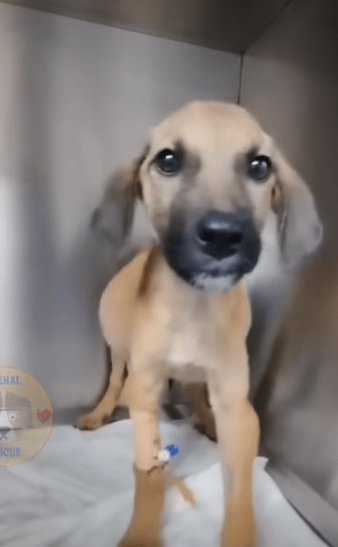
We named her Lucky. The name felt right, not because luck had spared her from the forest, but because she had been strong enough to hold on until love found her. Lucky taught us something profound—that even the deepest wounds can heal when met with patience, care, and compassion. Her journey was not only about physical recovery but about the rebirth of trust, the return of hope.
Today, Lucky’s belly no longer swells with illness, her tail wound has long healed, and her eyes no longer dart with suspicion. They shine with happiness and gratitude. She runs across the yard with the other dogs, her spirit unburdened, her heart free. The puppy who once trembled in the shadows of the forest now greets the world with courage.
Every time I see her, I am reminded that love changes everything. Lucky’s story is not only hers—it is a story for all of us. A story that proves no matter how dark the beginning, every life has the chance to find light again. And when I whisper her name, I know it is more than just a name—it is a testament to her survival, her transformation, and the love that saved her.

